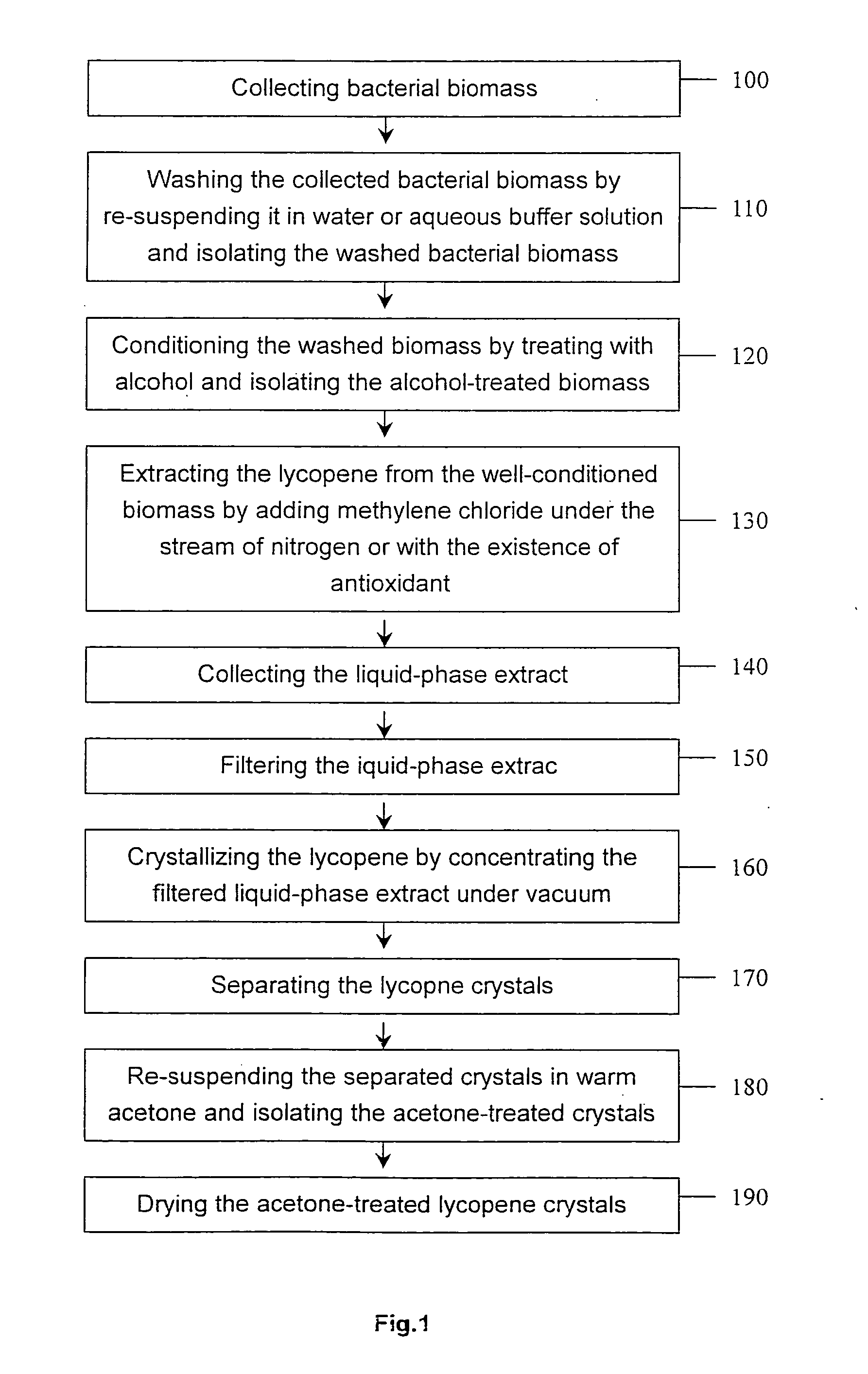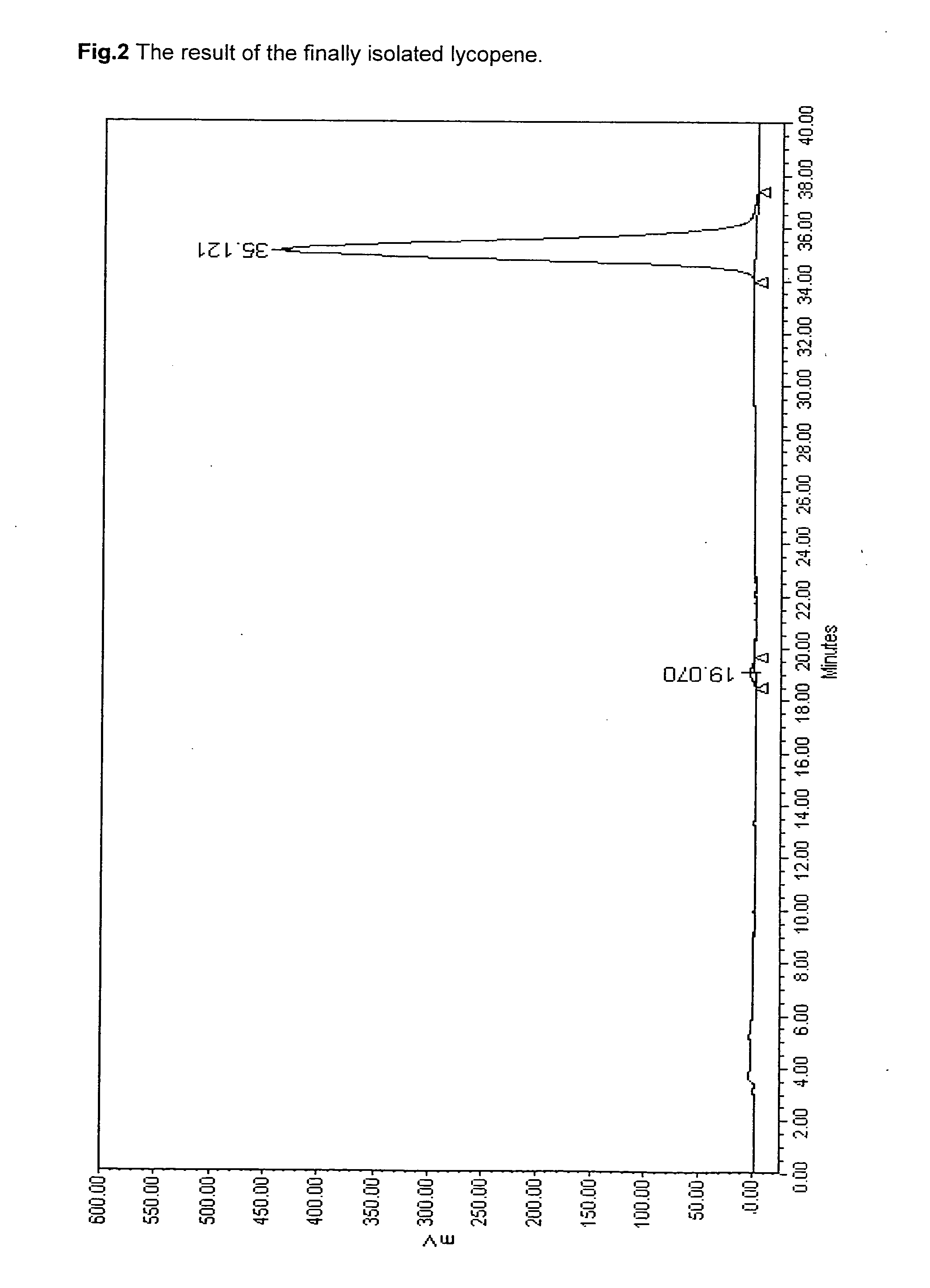Process for obtaining biosynthesized lycopene from bacterial cells and the purified lycopene of the same
a technology of lycopene and bacterial cells, which is applied in the field of isolating and purifying lycopene, can solve the problems of low purity, high cost of time, and long and complicated multiple steps, and achieve the effect of high recovery and increased purity
- Summary
- Abstract
- Description
- Claims
- Application Information
AI Technical Summary
Benefits of technology
Problems solved by technology
Method used
Image
Examples
example 1
[0038] 4.18 liters of fermentation broth, after the high-cell density fermentation of the genetically engineered E. coli containing lycopene synthesis genes, are harvested. The strength of the broth is 1.362 g of lycopene per liter. In order to harvest the biomass from the aforesaid broth, the broth is centrifuged at the speed of 12000 g for 20 minutes 100. The harvested biomass is mixed with 4.68 liters of 0.1 M dipotassium phosphate buffer and stirred for 30 minutes 110. Another centrifugation at the speed of 12000 g for 30 minutes is carried out again 110 and the precipitated biomass is then re-suspended in 3.14 liters of isopropanol 120. After being stirred slowly for 60 minutes, the biomass is recovered by centrifugation. A second re-suspension of centrifuged biomass in 2.09 liters of isopropanol is carried out and both the stirring step and centrifuging step are as the same as the steps in the previous isopropanol treatment of this invention 120. A wet biomass weighted 659.1 g...
example 2
[0040] 10 liters of fermentation broth after genetic engineered E. coli fermentation production is collected 100. The strength of the broth is 1.284 g of lycopene per liter. In order to harvest the biomass from the aforesaid broth, the broth is centrifuged at the speed of 12000 g for 20 minutes. The harvested biomass is mixed with 10 liters of water and stirring for 30 minutes 110. Another centrifugation at the speed of 12000 g for 30 minutes is carried out again and the precipitated biomass is re-suspended in 10 liters of isoprapanol 120. After stirring for 60 minutes, the biomass is recovered by centrifugation. A second re-suspension of centrifuged biomass in 10 liters of isopropanol is carried out 120 and both the stirring step and centrifuging step are as same as the steps in the previous isopropanol treatment.
[0041] The 2821 g collected wet biomass is extracted by mixing with 5.48 liters of methylene chloride and stirring under the stream of nitrogen for 30 minutes & 1.37 g BH...
PUM
| Property | Measurement | Unit |
|---|---|---|
| melting point | aaaaa | aaaaa |
| volume | aaaaa | aaaaa |
| weight | aaaaa | aaaaa |
Abstract
Description
Claims
Application Information
 Login to View More
Login to View More - R&D
- Intellectual Property
- Life Sciences
- Materials
- Tech Scout
- Unparalleled Data Quality
- Higher Quality Content
- 60% Fewer Hallucinations
Browse by: Latest US Patents, China's latest patents, Technical Efficacy Thesaurus, Application Domain, Technology Topic, Popular Technical Reports.
© 2025 PatSnap. All rights reserved.Legal|Privacy policy|Modern Slavery Act Transparency Statement|Sitemap|About US| Contact US: help@patsnap.com


